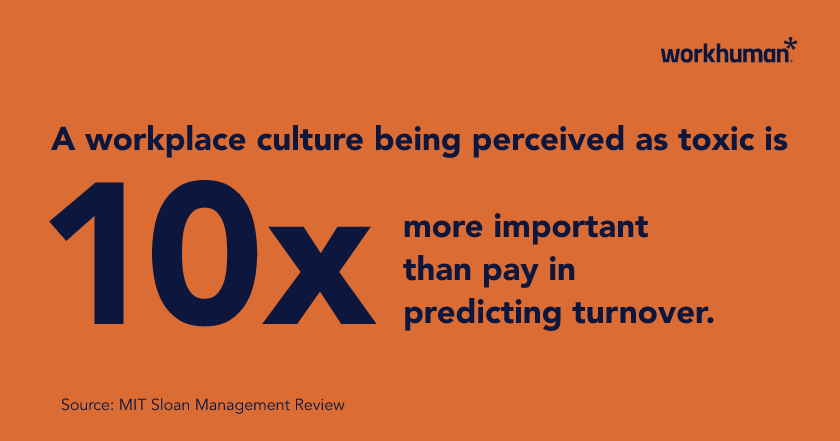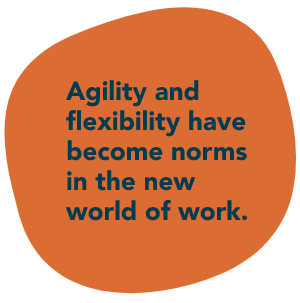8 Actionable Insights on How to Improve Company Culture

Company culture remains a hot and relevant topic in business and human resources specifically – yet it continues to be an elusive concept to define.
However, the speakers who held breakout sessions for the “Being a Champion of Workplace Culture” content track at Workhuman® Live did an excellent job at not only giving a clear and dynamic definition of the topic, but also providing practical action steps on how to improve company culture and turn your current organizational culture into one with improved employee retention and employee satisfaction.
The basics of organizational culture
While SHRMOpens in a new tab defines company culture as “the proper way to behave within an organization,” the subject matter experts (SMEs) at Workhuman Live Atlanta shared their own definitions that were more broadly encompassing.
What is a positive workplace culture?
Matt Whiat defined organizational culture as,
How we interact with people; with the organization through its mission, vision, values, and systems.

Whiat described a company’s culture as a feeling of inspiration that connects work to the company’s values, leading to a more positive employee experience.
What does positive employee experience look like?
During his keynote, Dan Heath also noted that great company culture is activated by peak moments and transition pointsOpens in a new tab. These are the moments of accomplishment or movement within an organization or an employee’s personal growth.

These moments can be based on positive or negative events – the most important thing is to intentionally notice the activities that take place in these moments to ensure you are creating a memorable, helpful experience for employees going forward.
During her “Emerging Evolved, Not Traumatized” session, Cy Wakeman talked about company culture as being co-created through accountability and energy management.

We achieve this positive company culture by showing empathy, empowering others, and staying neutral to the emotional reactions of others.
How does good company culture relate to diversity, equity, and inclusion (DE&I)?
In her session Brittany Janay Harris reminded us that company culture is,
the embodiment of core values, beliefs, and behaviors … for the purpose of disrupting exclusion and oppression.

This approach to company culture is what allows inclusion, equity, and authenticity to thrive.
And based on the insights shared at Workhuman Live, inclusion and authenticity are more than just proper behavior – it’s one of the requirements of a modern workplace culture.
Company culture is built on cultivated, intentional interactions that serve the purpose of creating and sustaining an inclusive and equitable environment.
Successful business leaders can facilitate this by leading with empathy, encouraging professional development opportunities, and leveraging employee recognition.
What does a negative culture look like?
According to the MIT Sloan Management ReviewOpens in a new tab, a culture being perceived as toxic is the primary reason people quit their jobs, and 10x more important than pay in predicting turnover.
So, it’s also useful to understand what a positive employee experience doesn’t look like.
Through the analysis of online employee reviews, the research shows the five most common situations cited as toxic culture are:
- Failure to promote diversity, equity, and inclusion (DE&I)
- Workers feeling disrespected
- Unethical behavior or low integrity
- Abusive managers
- A cutthroat environment where colleagues actively undermine one another
Even if there are only one or two employees who embody these traits, their toxic energy is more powerful than most expect.
From senior management down to an individual contributor, this negative energy can overpower even the most successful culture initiative, making it as important as ever to keep recognizing engaged employees when they do good work.

Defining how to improve company culture
With the expanded definition of company culture from Workhuman Live SMEs, improving workplace culture comes from three things: defining success, fostering accountability, and embracing ambassadorship.
1. Defining success and setting culture goals
From the job description and the key performance indicators to the standard procedures to the technology used in support, every aspect of an organization needs to have a definition of success.
Wakeman and Heath explained that because these definitions allow the organization to clearly see what greatness looks like in action, the organization and its leaders are better able to study and replicate these moments that matter.
These definitions also allow the organization to clearly show both how each individual’s effort directly relates to the company’s core values, but also how they contribute to the company’s success.
2. Fostering accountability and communicating consistently
Wakeman explained the problem with continuing to misname accountability by centering it on blame and punitive measures.
In actuality, accountability is about empowering people to make good decisions that lead to success for all. This can be done by providing the information, resources, and equipment needed for employees to do their best work.

Organizations waste time and a lot of money on making work more “fun,” thinking this is the key to thriving workplace culture. Whiat and other speakers made it clear that is not the case.
Achieving success through accountability lies in the willingness of an organization to support its people to the best of their ability.
3. Embracing ambassadorship and reinforcing positive behaviors
Organizational culture does not just belong to one person or one area of the organization. Every employee, manager, and leader in the organization plays a role in either advancing or impeding the health of a company’s culture.
A company culture quickly becomes an outward expression of inward experiences, according to Harris. If the employee experience is positive, culture will also be positive. If the employee experience is negative, though, it will quickly spread through the overall culture.
Because of that, the goal is to ensure as much of that outward expression and internal experience is positive, psychologically safe, and aligned with the purest intent of the organization’s beliefs and core values.
And considering how permeable these feelings are, organizations looking to improve company culture should make it a point to recognize those employees living and working in accordance with the core values of the company.
A recognition-rich culture is key to ensuring the employee experience is fulfilling and engaging.
4. Gathering feedback and establishing a culture committee
Putting these practices into place is one thing, but it will take work to ensure they are effective and accessible. A strong company culture is one that adapts to change in culture along with the needs of its employees, which is why feedback and ongoing communication is so vital.

To get positive results, organizations should establish a culture committee made up of different perspectives from around the company, in order to make sure the initiatives being put in place are serving those they are intended for.
What will organizational culture look like in the future?
Building a solid company culture is a long-term investment and doesn’t happen overnight, but the improved retention and engagement cost savings make it well worth it. Corporate culture in the future of work will have two distinct elements.
Improving employee engagement through revised organizational charts
Matt Whiat pointed out that, prior to World War II, the charts that organizations used to define the roles and reporting structure looked more like trees than pyramids.
Post-war, when veterans returned to the civilian workforce in leadership roles, they replicated the same chain-of-command style as they had followed while serving because it was most familiar to them.
Studies continue to show this militaristic, command/control style and structure are detrimental to building connections and cultivating innovation at work.

Organizations looking to create and maintain healthy, progressive company cultures should consider revising their strategies to improve organizational effectiveness and organizational structures to remove this kind of influence.
They will seek to dismantle practices that counteract employee engagement and equity that lead to negative consequences for the organization.
Cultivating authenticity through inclusion, equity, and diversity
As Brittany Janay Harris pointed out, authenticity cannot thrive where people cannot be accepted as their whole selves. They must be paid an equitable, living wage.
As we continue to move forward through the pandemic and redefine our diversity, equity, inclusion, and belonging strategies following the murder of George Floyd, organizations have to ensure a strong corporate culture and level of psychological safety in day-to-day operations for all employees.
Leaders looking to bring their business to the next level must be committed to making meaningful cultural changes by listening to how their employees feel, especially in terms of DE&I.
Continue to build trust by speaking with transparency and authenticity about the ways you are working to ensure fiscal and environmental security for all workers.
You might also like: Complete guide on how to change organizational culture
4 ways to improve a company’s culture
With all this in mind, being a champion for improving company culture will not be an easy endeavor, but it is critical for culture-building and company success.
Here are four practices leaders can begin to implement to improve your company culture and retain highly engaged employees:
1. Utilize the ideas and feedback of staff.
Drew Lewis said it best during the panel on Employee Resource Groups (ERGs):
This is the time to tap into the knowledge and passion of your people.

The pandemic, alongside the civil, racial, and political unrest over the last years, has thrust us into unprecedented times; times where no one can be 100% sure of what the world of work will look like when it is all said and done.
The only thing we know for sure is that the world of work will look very dissimilar to what it looked like yesterday, and what it looks like today. Organizations will have to evolve and adapt if they want to survive.
As Lorna Hagen put it: “We are entering a new industrial era … it’s all about knowledge workers … It is a human era.”

The good news is that your people know what they need to be successful in their jobs. If you ask them, they will not only tell you – but they will usually help you find low-risk, affordable methods to help you get there, which in turn helps them be more productive in their work.
Whether through ERGs or some other special committee/cohort, partner with your people on initiatives to ensure employee growth and development, business growth and success, and to have greater positive impact in the community. Through this approach, everyone wins.

2. Put humanity at the center of your decisions.
Whether it’s considering the “office vs. hybrid vs. remote” work conundrum from every angle or deciding to end a relationship with a vendor based on lack of environmental and social governance (ESG) commitments, humanity has to be a primary consideration.
As Harris put it, in order to be authentic we have to embody our core values and beliefs through our behaviors. This shift in behavior will not only require ongoing awareness of the needs of the organization and its employees, it will also require a commitment to justice, accountability, and continued reparation of harm.
From there leaders have the opportunity to replace those systems with new principles, procedures, frameworks, and methods that are intentionally designed to honor the humanity of all involved and have as much of a positive impact as possible.
Leaders can get to this new, more human system of operating by utilizing the answers and feedback from those within the organization.
Leaders must keep in mind, Peter Church explained, although employees may go through the same events, they each are thinking, feeling, and experiencing the changes differently.
We must tap into the voices of employees as well as continuously reflect on our desires, business goals, and core values in order to arrive at human-centered business decisions.
3. Cultivate mutually prosperous employment relationships.
Drew Lewis called this the “dual value proposition,” while Lorna Hagen described it as, “co-creating the business.” Whatever words used to describe this concept, the goal is to ensure the working relationship is beneficial to both the employer and the employee.
This relationship is not just an agreement about where the work gets done or how much money each employee is making. It is also about:
- Creating opportunities for employee and employer to flourish (Graham)
- Delivering on intentions that honor the needs and values of both employee and employer (Harris)
- Understanding the “right thing” for everyone is not necessarily going to be the same thing for everyone (Church)
Through this, we accept that the employment relationship is not one of subservience or servitude – but one where both entities give and bring out the best in each other for as long as they can.
And when the best is no longer possible for one party or the other, they are honest with each other and step away willingly, giving the other consideration, dignity, and grace.
4. Embrace and encourage vulnerability.
The last two years have made it clear that every employee has unique needs and experiences that must be acknowledged and honored by an organization’s leadership team.

It has also revealed that many of the societal, physical, and mental health norms are not quite as resilient than we have previously been willing to admit. This makes the need for being more open and accommodating in our workplaces more necessary than ever.
Agility and flexibility have also become norms in the new world of work, highlighting the importance of developing organizational agility competency. And as the line between work and life continues to blend, vulnerability is quickly becoming just as important of a skill.
This requires those in leadership positions to increase their self-awareness, to become more attuned to the atypical needs of others, and to be willing to entangle themselves in uncomfortable conversations in order to find innovative solutions that work to improve company culture.
For Hagen that means investing heavily in the quality of the training, coaching, and support for middle managers. Kumari Williams also mentioned the importance of planning for succession with these skills in mind.
Corporate culture will continue to feel elusive if we fail to approach it with openness, authenticity, and intention. The advice provided by the SMEs at Workhuman Live provides us with a practical blueprint we can follow in an effort to improve company culture.
With this blueprint, leaders can take the pulse of their current workplace culture and redirect it to a more human culture that embraces the needs of all of its employees.
By remembering that we are all champions for strong company culture, business leaders have the chance to embrace the opportunity their role provides to influence employee engagement and experience.
About the author
Sarah Morgan
Sarah Morgan is the Founder and Chief Excellence Officer at BuzzARooney LLC, a management consulting firm.